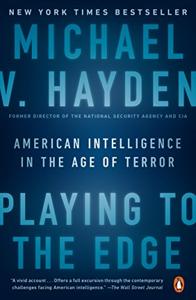
Want to learn the ideas in Playing to the Edge better than ever? Read the world’s #1 book summary of Playing to the Edge by Michael V. Hayden here.
Read a brief 1-Page Summary or watch video summaries curated by our expert team. Note: this book guide is not affiliated with or endorsed by the publisher or author, and we always encourage you to purchase and read the full book.
Video Summaries of Playing to the Edge
We’ve scoured the Internet for the very best videos on Playing to the Edge, from high-quality videos summaries to interviews or commentary by Michael V. Hayden.
1-Page Summary of Playing to the Edge
Overview
Playing to the Edge is a book written by Michael Hayden, who served as the head of both the National Security Agency (NSA) and Central Intelligence Agency (CIA). He uses his own experiences to discuss how intelligence agencies operate. The term “playing to the edge” refers to athletes playing their best while staying within rules of competition.
Following the September 11, 2001 terrorist attacks on the United States, new programs were created to keep people safe. These programs included metadata surveillance and aerial drones. Some of these programs were controversial when they became public knowledge because they were conducted without civilian oversight or public awareness. Other concerns for the intelligence community during this time period included cyber warfare and growing Iranian power in the Middle East.
The intelligence community (IC) is responsible for protecting the United States while staying within US laws. The IC must also protect personal liberties and privacy, but they can only do so by working to the edge of those boundaries.
Key Takeaways
After 9/11, the US government launched digital surveillance programs to better protect Americans. These efforts were carefully designed so that they would not invade citizens’ privacy. Cyber warfare became a major national security concern in the 21st century. The US responded by developing offensive cyber operations. In 2004, Congress passed legislation intended to centralize intelligence efforts and created a new position: director of National Intelligence (DNI).
As a result of the media’s coverage after 9/11, public opinion became increasingly critical of US intelligence practices. Although drone strikes against terrorist targets don’t solve the underlying causes of terrorism, both Bush and Obama used them extensively. The threat posed by Iran was one of the primary concerns for intelligence agencies in the decade following 2003.
The national security community should carefully balance the need for safety and privacy concerns.
George W. Bush, despite having experienced people in his cabinet to help him with foreign policy issues, always took the lead on those issues in the White House.
Key Takeaway 1: After the September 11, 2001, terrorist attacks, US intelligence agencies launched digital surveillance efforts intended to better protect Americans. Careful safeguards were put into these programs to protect the privacy of US citizens.
The War on Terror has led to increased surveillance, and this is a negative aspect of the war. During the Cold War, spying was easier because the Soviet Union had millions of citizens and territory. It was difficult for spies to infiltrate but possible. However, terrorist organizations are harder to infiltrate because they have fewer members than countries do. Furthermore, since there were more Russian-speaking people during the Cold War when we were fighting Russia, there are now not as many Middle East experts in our intelligence community compared to then.
Stellarwind and other data collection programs were successful in allowing the intelligence community, as well as law enforcement, to track terrorists. Many oversight measures were put into place to prevent misuse of these programs. The Foreign Intelligence Surveillance Court must approve the collection of metadata.
Key Takeaway 2: Cyber warfare emerged as a pressing national security concern in the twenty-first century. The United States responded to the perceived threat by developing offensive cyber operations.
Cyber warfare is different from regular warfare because it’s harder to gather information about the enemy. In 2004, 75,000 attempts were made by hackers to gain access to DoD servers and databases. The psychological impact of a cyber attack can be greater than its economic or political impact, as demonstrated by the 2014 hack on Sony over a satirical film mocking North Korea.






